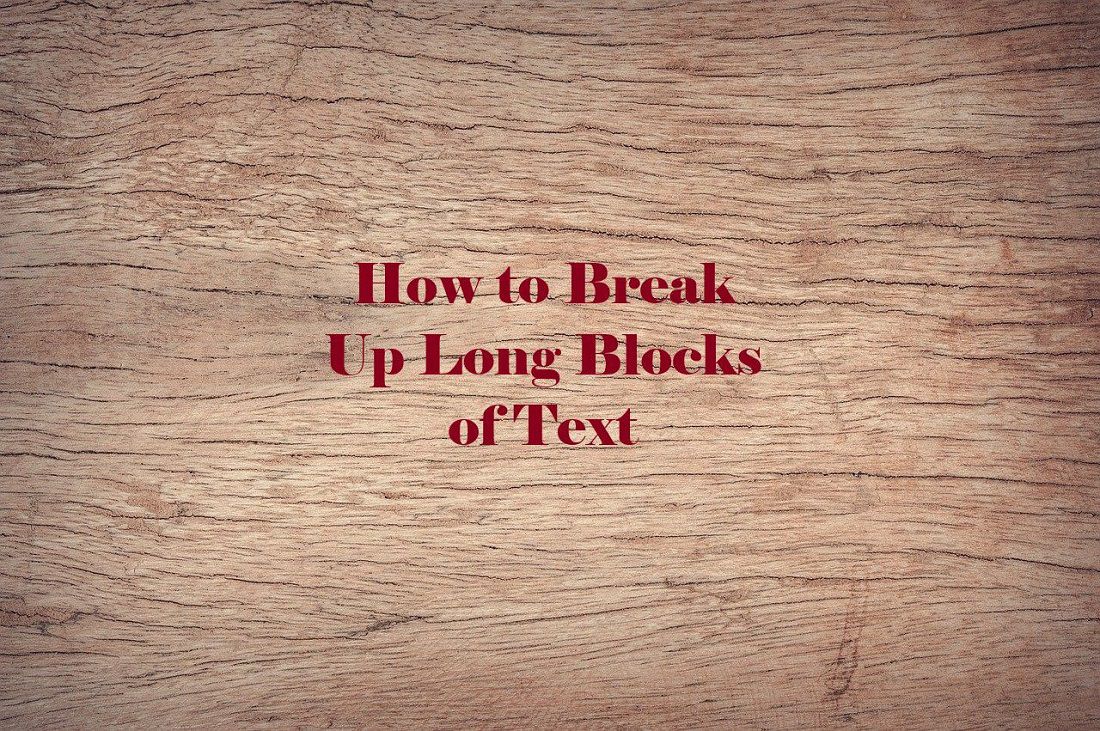It is fairly common these days to see online content formatted with lots of headings, bullet points, and short paragraphs and sentences. Compare modern online writing to what book authors produced 100 years ago and you’ll see quite a difference. What you observe is no accident.
Good writers in the modern era do what they do with purpose. They have come to understand that breaking up long blocks of text with formatting features benefits readers. They know that happy readers are likely to read all the way through to the end. And that is the ultimate goal, is it not?
I follow modern standards for breaking up long blocks of text. You should notice this even in this post. Keep reading to learn why I do it. Needless to say it works. Breaking up long blocks of text accomplishes two very specific purposes that good writers are cognisant of.
Modern Reading Habits
Accommodating modern reading habits is the more important of the two purposes. Years of research have revealed that content readers in the 21st century are more likely to skim articles before deciding whether or not to read them in their entirety. There could be any number of reasons for this:
- Skimming is faster and easier
- It is less stressful on the eyes
- People do not have time to read complete articles.
We don’t really know why skimming is the new normal. From the writer’s perspective, the reasons are irrelevant. It is more important to understand that skimming gives the brain the opportunity to gather a limited amount of information before a reader decides whether or not to consume the entire piece of content.
Headings, Subheadings, and Bullets
If you are like most readers, you have already skimmed this post. You read the headline to get a basic understanding of what the post was about. You have already skimmed the headings, subheadings, and bullets for more information. The fact that you are now reading in detail demonstrates that your mind is interested in more information.
Good writers break up long blocks of text with a number of formatting tools, beginning with headings. The purpose of the heading is to introduce the next line of thought being pursued in that text. Well-written headings can give you an overview of the entire piece of content without actually requiring you to read it in full.
Subheadings introduce complementary thoughts within that original line of thought. These are further complemented by bullet points and lists that are utilised to provide bite-size chunks of information that are easy to consume.
All of these formatting tools facilitate easier skimming. More importantly, they make content easier to follow for those readers who decide to consume every word.
Shorter Attention Spans
An extension of the skimming issue is the general trend toward shorter attention spans. Though experts have been debating for several years whether or not attention spans are getting shorter, research out of four prominent universities – including Kings College London and Harvard – reveals evidence suggesting that attention spans are getting shorter.
The culprit appears to be internet use. Our attention spans are getting shorter because the internet has us thinking in shorter bursts. Social media posts are purposely short. Videos lack detail by necessity. Simply put, internet use is training us to pay less attention to large blocks of information.
This creates a very real problem for writers. They would love to string together long sentences and paragraphs filled with big words and philosophical analogies. But that creates walls of text that turn readers away.
Good writers know that large blocks of text alienate readers before they even start skimming. If a reader sees one long paragraph after another, with no breaks in between, he or she is rather inclined to skip that article and move on to something easier. He/she does not have the attention span to consume that much content.
On the other hand, breaking up large blocks of text creates content that seems less intimidating. Readers will put the time and effort into consuming that content if each sentence and paragraph is compelling enough to build on the one before.
Making Google Happy
It is nearly impossible to talk about content creation techniques without returning to Google at some point. Therein lies the second purpose for breaking up large blocks of text with formatting tools. Believe it or not, doing so helps search engine algorithms.
Google’s algorithms are sophisticated enough to be able to analyse headings, subheadings, and lists. Indeed, that’s why content creators use specific tags in their content. For example, the <H1> tag tells search engines that a section of text is likely the title of the content.
Search algorithms are capable of scanning content just like human beings. More importantly, they do just that. Search engines scan pages for clues as to what content is about. They compare the resulting analysis with data gleaned from the entirety of the content to determine relevance.
If you know anything about SEO these days, you know just how important relevance is. If the main body of a piece of content does not match its headings and subheadings, it will get low marks for relevance. That’s a sure way to harm search engine results.
In Summary
Good writers break up long blocks of text in order to appeal to both readers and search engine algorithms. Readers are the more important of the two, so writers create their content to accommodate modern reading habits. They combine short paragraphs and sentences with formatting tools to make content easier to read.
Now you know the purpose behind breaking up text. Give it a try when you compose your next blog or guest post.
